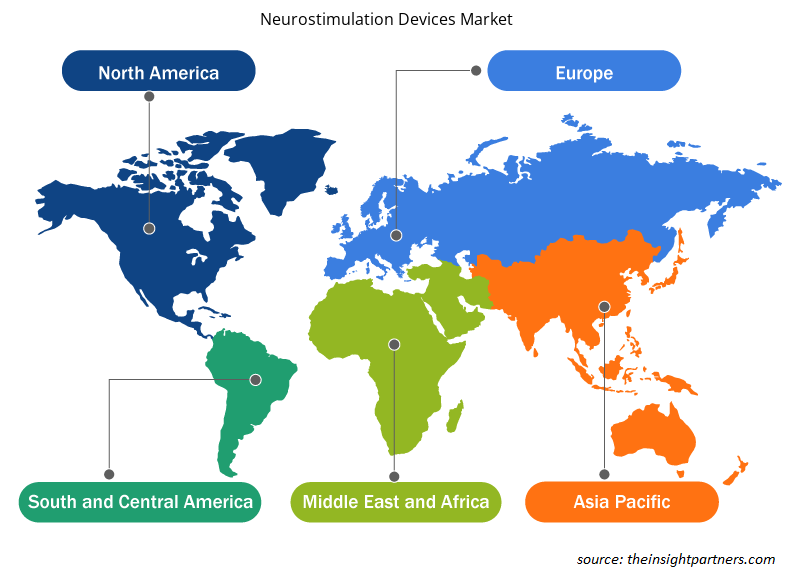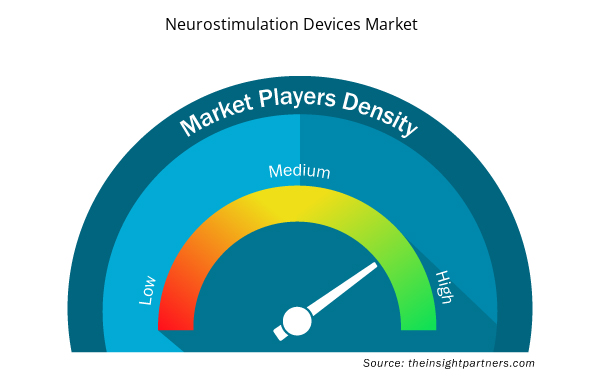[調査レポート] 神経刺激装置市場は、2022年の58億247万米ドルから成長し、2030年には118億2595万米ドルに達すると予想されており、2022年から2030年にかけて9.3%のCAGRを記録すると予想されています。
市場洞察とアナリストの見解:
神経刺激装置は、神経系の活動を調整するように設計された医療機器です。さまざまな神経疾患や慢性疼痛の治療に使用されます。神経刺激装置には、脊髄刺激装置、脳深部刺激装置、迷走神経刺激装置、末梢神経刺激装置など、いくつかの種類があります。これらの装置は、さまざまな神経疾患を持つ人々の生活の質を大幅に改善することができます。神経疾患の罹患率の増加と脊髄損傷症例の増加は、市場発展の背後にある主な要因です。しかし、専門家の不足が神経 刺激装置市場の成長を妨げています。
成長の原動力と課題:
高齢者は神経疾患にかかりやすいです。高齢者によく見られる神経疾患は、神経障害、パーキンソン病、アルツハイマー病、ジストニアなどです。国立衛生研究所 (NIH) によると、世界の人口の 8.5% (約 6 億 1,700 万人) が 65 歳以上です。米国やカナダなどの国では、高齢者人口の増加に伴い、運動障害や精神疾患の有病率が高くなっています。パーキンソン病財団によると、パーキンソン病の症状は平均年齢 60 歳でよく見られます。
カナダ心理学会によると、強迫性障害 (OCD) はカナダの人口の約 2% に影響を与えています。世界保健機関 (WHO) によると、てんかんは発作を引き起こす神経疾患で、世界中で約 5,000 万人が罹患しています。米国神経学会によると、脳卒中は米国で 3 番目に多い死因であり、アルツハイマー病が 6 番目に多い原因となっています。同じ情報源の統計によると、パーキンソン病に罹患している米国人は 100 万人近くおり、毎年少なくとも 6 万人の新規症例が報告されています。神経疾患の発生率の増加と、うつ病や慢性疼痛などの生活習慣病が相まって、技術的に高度な製品の採用が増えています。
WHO によると、神経疾患は世界の疾病負担の約 6.3% を占めています。また、同じ情報源によると、神経疾患は世界中で主要な死亡原因の 1 つです。先進国では死亡の 13.2%、低所得国および中所得国では 16.8% が神経疾患によるものです。死亡率と疾病負担が高いため、長期的な解決策を組み込む臨床上の緊急性が必要です。さらに、神経疾患の多大な負担に関する認識が高まるにつれて、治療薬としての神経刺激装置の需要が高まっています。
したがって、神経疾患にかかりやすい高齢者人口の増加、疾患の有病率の上昇、神経障害の多大な負担に関する意識の高まりが、神経刺激装置の市場規模を押し上げています。
要件に合わせてレポートをカスタマイズする
このレポートの一部、国レベルの分析、Excelデータパックなど、あらゆるレポートを無料でカスタマイズできます。また、スタートアップや大学向けのお得なオファーや割引もご利用いただけます。
- このレポートの主要な市場動向を入手してください。この無料サンプルには、市場動向から見積もりや予測に至るまでのデータ分析が含まれます。
レポートのセグメンテーションと範囲:
世界の神経刺激装置市場は、製品、用途、およびエンドユーザーに基づいてセグメント化されています。製品に基づいて、市場は脊髄刺激装置、深部脳刺激装置、仙骨神経刺激装置、および迷走神経刺激装置に分類されます。用途の面では、神経刺激装置市場は、疼痛管理、てんかん、尿失禁および便失禁、パーキンソン病などに分類されます。エンドユーザー別に、神経刺激装置市場は、病院、専門クリニック、その他に分類されます。神経刺激装置市場は、地域別に、北米(米国、カナダ、メキシコ)、欧州(ドイツ、フランス、イタリア、英国、ロシア、その他の欧州)、アジア太平洋(オーストラリア、中国、日本、インド、韓国、その他のアジア太平洋)、中東およびアフリカ(南アフリカ、サウジアラビア、UAE、その他の中東およびアフリカ)、南米および中米(ブラジル、アルゼンチン、その他の南米および中米)に分類されています。
セグメント分析:
製品に基づいて、神経刺激装置市場は、脊髄刺激装置、深部脳刺激装置、仙骨神経刺激装置、迷走神経刺激装置、その他に分類されます。脊髄刺激装置セグメントは2022年に最大の市場シェアを占め、2022年から2030年にかけてより高いCAGRを記録すると予想されています。脊髄刺激は、背中の手術の失敗/くも膜炎、神経障害性疼痛/神経障害、複合性局所疼痛症候群/反射性交感神経性ジストロフィーなど、さまざまな状態による重度の慢性疼痛の患者を治療できます。いくつかのSCSデバイスは、低周波電流を使用して、知覚異常と呼ばれる軽いチクチク感で痛みの感覚を変えます。他のSCSデバイスは、チクチク感なしで痛みを隠すために高周波またはバーストパルスを使用します。
脊髄刺激療法は、さまざまな慢性疼痛状態を治療するための介入的疼痛管理の基本となっています。1967年の最初の発足以来進歩が遂げられ、低侵襲配置と内蔵バッテリーを可能にする新技術が生まれました。たとえば、2023年5月、アボットは米国食品医薬品局(FDA)から、非外科的腰痛として知られる、腰手術を受けることができない人の慢性腰痛を治療するためのSCSデバイスの承認を取得しました。さらに、2023年8月、メドトロニックは、閉ループ充電式SCSのInceptivでCEマークの承認を取得しました。これは、各人の固有の生物学的信号を感知し、必要に応じて毎瞬間刺激を調整して、日常生活の動きと調和した治療を維持する閉ループ機能を提供する最初のメドトロニックSCSデバイスです。このような開発によりSCSの採用が促進され、世界の神経刺激デバイス市場におけるセグメントの成長が促進されています。
神経刺激装置市場は、用途別に、疼痛管理、てんかん、尿失禁および便失禁、パーキンソン病、その他に分類されています。疼痛管理セグメントは2022年に最大の市場シェアを占め、2022年から2030年にかけてより高いCAGRを記録すると予想されています。
慢性的な痛みは、高齢者、外傷や手術を受けた患者、さまざまな治療を受けている人、さまざまな身体的および精神的状態に関係する人に影響を与えます。米国疾病予防管理センター (CDC) によると、腰痛は病院に行く理由の第 2 位であり、生涯で約 60% から 80% の人が腰痛を経験しており、入院や手術の主な理由の 1 つとなっています。
神経刺激は、慢性的な痛みを和らげるより安全で効率的な解決策であり、広く採用されています。多くのバイオテクノロジー企業が、オピオイド中毒者が痛みやその他の離脱症状を克服するのを助けるために神経刺激装置を発売しています。たとえば、2021年4月、大手医療機器会社であるSpark Biomedicalは、オピオイド中毒者が離脱症状を乗り越えるのを助けるために、Sparrow Therapy Systemと呼ばれる新しい神経刺激装置を発表しました。この装置は、低用量の電気を使用してエンドルフィンの生成を刺激し、患者が離脱中に経験する痛みや恐怖を和らげるのに役立ちます。さらに、2021年3月、Mainstay Medicalはオーストラリアで慢性腰痛(CLBP)用の埋め込み型神経刺激装置ReActiv8を発売しました。この装置は、腰部多裂筋の機能不全に関連する難治性CLBPの成人に役立つ可能性があります。 2023年1月、FDAは糖尿病性末梢神経障害患者の慢性疼痛管理をサポートするアボット社のProclaim XR脊髄神経刺激システムを承認しました。したがって、上記の用途と利点は、2022年から2030年にかけて神経刺激装置市場にプラスの影響を与えるでしょう。
地域分析:
地理に基づいて、神経刺激装置市場は、北米、ヨーロッパ、アジア太平洋、中南米、中東およびアフリカの5つの主要地域に分かれています。北米の市場は、米国、カナダ、メキシコの3つの主要国に主に焦点を当てて分析されています。米国は、2022年に北米の神経刺激装置市場で最大のシェアを占めました。神経疾患の有病率の増加、研究開発への多額の支出、米国食品医薬品局(FDA)による製品承認、および技術の進歩により、予測期間中に北米の神経刺激装置市場で最大のシェアを占めると推定されています。米国では、神経血管疾患の発生率が大幅に上昇しており、主な死亡原因になりつつあります。パーキンソン病(PD)などの神経疾患の発生率の上昇、神経障害に関する意識の高まり、経頭蓋刺激装置の開発への投資の増加は、米国の神経刺激装置市場全体を牽引する主な要因の1つです。脳深部刺激(DBS)装置は、パーキンソン病に伴う震えを効果的に抑制することが確認されている。ドーパミン値の低下やその他の遺伝的要因は、パーキンソン病の主な原因の1つである。アルツハイマー病協会が発表した「2022年アルツハイマー病の事実と数字」と題された研究によると、2022年には65歳以上のアメリカ人約650万人がアルツハイマー病と診断された。その数は2060年までに1,380万人に増加すると予測されている。パーキンソン病財団によると、米国でパーキンソン病を患う人の数は2030年までに120万人に増加すると予想されている。技術の進歩と新製品の発売が神経刺激装置市場を牽引している。2020年1月、アボットの神経刺激装置Infinity DBSシステムは、パーキンソン病の治療薬として米国食品医薬品局(FDA)の承認を受けた。このシステムにより、パーキンソン病の症状に関連する脳の特定の領域、淡蒼球内部 (GPi) を標的とした治療が可能になります。したがって、神経疾患の罹患率の増加と技術の進歩により、米国における神経刺激装置市場の成長が促進されています。
競争環境と主要企業:
神経刺激装置市場の発展は、有機的および無機的成長戦略として特徴付けられています。さまざまな企業が、製品の発売、拡張、強化、移転などの有機的成長戦略に重点を置いています。市場における無機的成長戦略は、合併と買収、パートナーシップ、コラボレーションです。これらの活動は、神経刺激装置市場のプレーヤーのビジネスと顧客基盤の拡大への道を開きました。
- 2023 年 8 月、Mainstay Medical Holdings plc は、難治性慢性腰痛の治療を目的とした ReActiv8 の RESTORE ランダム化臨床試験の登録が完了したことを発表しました。この試験は、ReActiv8 回復神経刺激療法を現在の治療パラダイムに追加すると、腰痛関連の障害が大幅に改善されるという仮説をテストするために、最適化された医療管理と直接比較するように設計されています。
- 2023 年 4 月、Synapse Biomedical, Inc. は、脊髄損傷を患い人工呼吸器を必要とする患者に使用するための NeuRx 横隔膜ペーシング システム (NeuRx DPS) の FDA 承認 (PMA) を発表しました。PMA は、FDA が要求する最も厳格なタイプのデバイス マーケティング アプリケーションです。
- 2023 年 8 月、アボットは、米国食品医薬品局 (FDA) が FlexBurst360 療法を特徴とする新しい Proclaim Plus 脊髄刺激 (SCS) システムを承認したことを発表しました。アボット独自の BurstDR 刺激の次世代である FlexBurst360 療法は、体幹および/または四肢の 6 つの領域にわたる痛みをカバーします。これにより、患者の治療ニーズの変化に応じて調整可能なプログラミングが可能になります。
- 2023年5月、アボットは、背中の手術を受けていない、または受ける資格がない人の慢性的な背中の痛み、いわゆる非外科的背中の痛みの治療を目的とした脊髄刺激(SCS)デバイスが米国食品医薬品局(FDA)の承認を受けたと発表しました。
- 2021 年 1 月、メドトロニック社は、最長 11 年間まで最適化できるデバイス寿命を備えた高性能の再充電不要の植込み型神経刺激装置 (INS) である Vanta の米国食品医薬品局 (FDA) の承認を取得しました。Vanta 神経刺激装置は、同等の設定で競合の一次細胞デバイスと比較してほぼ 2 倍のデバイス寿命を実現します。
- 2022年1月、メドトロニック社は、糖尿病性末梢神経障害(DPN)に伴う慢性疼痛の治療薬として、充電式神経刺激装置Intellisと充電不要の神経刺激装置Vantaについて米国食品医薬品局の承認を取得しました。
神経刺激装置市場の地域別洞察
予測期間を通じて神経刺激装置市場に影響を与える地域的な傾向と要因は、Insight Partners のアナリストによって徹底的に説明されています。このセクションでは、北米、ヨーロッパ、アジア太平洋、中東およびアフリカ、南米および中米にわたる神経刺激装置市場のセグメントと地理についても説明します。

- 神経刺激装置市場の地域別データを入手
神経刺激装置市場レポートの範囲
| レポート属性 | 詳細 |
|---|---|
| 2022年の市場規模 | 58億米ドル |
| 2030年までの市場規模 | 118.3億米ドル |
| 世界のCAGR(2022年 - 2030年) | 9.3% |
| 履歴データ | 2020-2021 |
| 予測期間 | 2023-2030 |
| 対象セグメント | 製品別
|
| 対象地域と国 | 北米
|
| 市場リーダーと主要企業プロフィール |
|
神経刺激装置市場のプレーヤー密度:ビジネスダイナミクスへの影響を理解する
神経刺激装置市場は、消費者の嗜好の変化、技術の進歩、製品の利点に対する認識の高まりなどの要因により、エンドユーザーの需要が高まり、急速に成長しています。需要が高まるにつれて、企業は提供を拡大し、消費者のニーズを満たすために革新し、新たなトレンドを活用し、市場の成長をさらに促進しています。
市場プレーヤー密度とは、特定の市場または業界内で活動している企業または会社の分布を指します。これは、特定の市場スペースに、その規模または総市場価値と比較して、どれだけの競合相手 (市場プレーヤー) が存在するかを示します。
神経刺激装置市場で事業を展開している主要企業は次のとおりです。
- メドトロニック
- ボストン・サイエンティフィック
- アボットラボラトリーズ
- ネブロ社
- リヴァノヴァ社
免責事項:上記の企業は、特定の順序でランク付けされていません。

- 神経刺激装置市場のトップキープレーヤーの概要を入手
企業プロフィール
- メドトロニック
- ボストン・サイエンティフィック
- アボットラボラトリーズ
- ネブロ社
- リヴァノヴァ社
- シナプスバイオメディカル株式会社
- ナルメディカル株式会社
- エレクトロコア株式会社
- マイクロトランスポンダー株式会社
- メインステイメディカル
- 過去2年間の分析、基準年、CAGRによる予測(7年間)
- PEST分析とSWOT分析
- 市場規模価値/数量 - 世界、地域、国
- 業界と競争環境
- Excel データセット



Report Coverage
Revenue forecast, Company Analysis, Industry landscape, Growth factors, and Trends

Segment Covered
This text is related
to segments covered.

Regional Scope
North America, Europe, Asia Pacific, Middle East & Africa, South & Central America

Country Scope
This text is related
to country scope.
よくある質問
The factors that are driving the market is the growing prevalence of neurological diseases and increasing cases of spinal cord injury are the key driving factors behind the market development. However, lack of expert professionals is hampering the market growth.
The neurostimulation devices market majorly consists of the players such Medtronic Plc, Boston Scientific Corp; Abbott Laboratories, Nevro Corp; LivaNova Plc, Synapse Biomedical Inc, Nalu Medical, Inc, ElectroCore Inc; MicroTransponder Inc, and Mainstay Medical among others.
The neurostimulation devices market is analyzed in the product, application, and end user. The market based on product, is segmented into spinal cord stimulator, deep brain stimulator, sacral nerve stimulator, vagus nerve stimulator, and others. The spinal cord stimulator segment held a larger market share in 2022 and the same is anticipated to register a higher CAGR during the 2022-2030. The neurostimulation devices market, by application, is segmented into pain management, epilepsy, urinary and fecal incontinence, Parkinson’s disease, and others. The pain management segment held a larger market share in 2022 and the same is anticipated to register a higher CAGR during the 2022-2030. The neurostimulation devices market, by end user, is bifurcated into hospitals, specialty clinics, and others. The hospitals segment held the largest share of the market in 2022 and specialty clinics segment is anticipated to register the highest CAGR in the market during 2022-2030.
Neurostimulation devices are medical devices designed to modulate the activity of the nervous system. They are used to treat various neurological conditions and chronic pain. There are several types of neurostimulation devices, including spinal cord stimulators, deep brain stimulators, vagus nerve stimulators, peripheral nerve stimulator. These devices have the potential to significantly improve the quality of life for individuals with various neurological conditions.
Trends and growth analysis reports related to Life Sciences : READ MORE..
The List of Companies - Neurostimulation Devices Market
- Medtronic Plc
- Boston Scientific Corp
- Abbott Laboratories
- Nevro Corp
- LivaNova Plc
- Synapse Biomedical Inc
- Nalu Medical, Inc
- ElectroCore Inc
- MicroTransponder Inc
- Mainstay Medical
The Insight Partners performs research in 4 major stages: Data Collection & Secondary Research, Primary Research, Data Analysis and Data Triangulation & Final Review.
- Data Collection and Secondary Research:
As a market research and consulting firm operating from a decade, we have published and advised several client across the globe. First step for any study will start with an assessment of currently available data and insights from existing reports. Further, historical and current market information is collected from Investor Presentations, Annual Reports, SEC Filings, etc., and other information related to company’s performance and market positioning are gathered from Paid Databases (Factiva, Hoovers, and Reuters) and various other publications available in public domain.
Several associations trade associates, technical forums, institutes, societies and organization are accessed to gain technical as well as market related insights through their publications such as research papers, blogs and press releases related to the studies are referred to get cues about the market. Further, white papers, journals, magazines, and other news articles published in last 3 years are scrutinized and analyzed to understand the current market trends.
- Primary Research:
The primarily interview analysis comprise of data obtained from industry participants interview and answers to survey questions gathered by in-house primary team.
For primary research, interviews are conducted with industry experts/CEOs/Marketing Managers/VPs/Subject Matter Experts from both demand and supply side to get a 360-degree view of the market. The primary team conducts several interviews based on the complexity of the markets to understand the various market trends and dynamics which makes research more credible and precise.
A typical research interview fulfils the following functions:
- Provides first-hand information on the market size, market trends, growth trends, competitive landscape, and outlook
- Validates and strengthens in-house secondary research findings
- Develops the analysis team’s expertise and market understanding
Primary research involves email interactions and telephone interviews for each market, category, segment, and sub-segment across geographies. The participants who typically take part in such a process include, but are not limited to:
- Industry participants: VPs, business development managers, market intelligence managers and national sales managers
- Outside experts: Valuation experts, research analysts and key opinion leaders specializing in the electronics and semiconductor industry.
Below is the breakup of our primary respondents by company, designation, and region:

Once we receive the confirmation from primary research sources or primary respondents, we finalize the base year market estimation and forecast the data as per the macroeconomic and microeconomic factors assessed during data collection.
- Data Analysis:
Once data is validated through both secondary as well as primary respondents, we finalize the market estimations by hypothesis formulation and factor analysis at regional and country level.
- Macro-Economic Factor Analysis:
We analyse macroeconomic indicators such the gross domestic product (GDP), increase in the demand for goods and services across industries, technological advancement, regional economic growth, governmental policies, the influence of COVID-19, PEST analysis, and other aspects. This analysis aids in setting benchmarks for various nations/regions and approximating market splits. Additionally, the general trend of the aforementioned components aid in determining the market's development possibilities.
- Country Level Data:
Various factors that are especially aligned to the country are taken into account to determine the market size for a certain area and country, including the presence of vendors, such as headquarters and offices, the country's GDP, demand patterns, and industry growth. To comprehend the market dynamics for the nation, a number of growth variables, inhibitors, application areas, and current market trends are researched. The aforementioned elements aid in determining the country's overall market's growth potential.
- Company Profile:
The “Table of Contents” is formulated by listing and analyzing more than 25 - 30 companies operating in the market ecosystem across geographies. However, we profile only 10 companies as a standard practice in our syndicate reports. These 10 companies comprise leading, emerging, and regional players. Nonetheless, our analysis is not restricted to the 10 listed companies, we also analyze other companies present in the market to develop a holistic view and understand the prevailing trends. The “Company Profiles” section in the report covers key facts, business description, products & services, financial information, SWOT analysis, and key developments. The financial information presented is extracted from the annual reports and official documents of the publicly listed companies. Upon collecting the information for the sections of respective companies, we verify them via various primary sources and then compile the data in respective company profiles. The company level information helps us in deriving the base number as well as in forecasting the market size.
- Developing Base Number:
Aggregation of sales statistics (2020-2022) and macro-economic factor, and other secondary and primary research insights are utilized to arrive at base number and related market shares for 2022. The data gaps are identified in this step and relevant market data is analyzed, collected from paid primary interviews or databases. On finalizing the base year market size, forecasts are developed on the basis of macro-economic, industry and market growth factors and company level analysis.
- Data Triangulation and Final Review:
The market findings and base year market size calculations are validated from supply as well as demand side. Demand side validations are based on macro-economic factor analysis and benchmarks for respective regions and countries. In case of supply side validations, revenues of major companies are estimated (in case not available) based on industry benchmark, approximate number of employees, product portfolio, and primary interviews revenues are gathered. Further revenue from target product/service segment is assessed to avoid overshooting of market statistics. In case of heavy deviations between supply and demand side values, all thes steps are repeated to achieve synchronization.
We follow an iterative model, wherein we share our research findings with Subject Matter Experts (SME’s) and Key Opinion Leaders (KOLs) until consensus view of the market is not formulated – this model negates any drastic deviation in the opinions of experts. Only validated and universally acceptable research findings are quoted in our reports.
We have important check points that we use to validate our research findings – which we call – data triangulation, where we validate the information, we generate from secondary sources with primary interviews and then we re-validate with our internal data bases and Subject matter experts. This comprehensive model enables us to deliver high quality, reliable data in shortest possible time.


 このレポートの無料サンプルを入手する
このレポートの無料サンプルを入手する